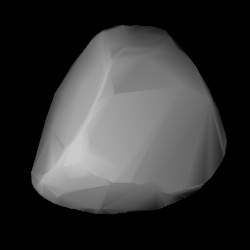 Modelled shape of Notburga from its lightcurve | |
| Discovery | |
|---|---|
| Discovered by | August Kopff |
| Discovery site | Heidelberg |
| Discovery date | 11 February 1907 |
| Designations | |
| (626) Notburga | |
| Pronunciation | /nɒtˈbɜːrɡə/ |
Named after | Saint Notburga |
| 1907 XO | |
| Orbital characteristics [1] | |
| Epoch 31 July 2016 (JD 2457600.5) | |
| Uncertainty parameter 0 | |
| Observation arc | 109.14 yr (39863 d) |
| Aphelion | 3.1985 AU (478.49 Gm) |
| Perihelion | 1.9481 AU (291.43 Gm) |
| 2.5733 AU (384.96 Gm) | |
| Eccentricity | 0.24295 |
| 4.13 yr (1507.8 d) | |
| 277.12° | |
| 0° 14m 19.536s / day | |
| Inclination | 25.371° |
| 341.645° | |
| 43.678° | |
| Physical characteristics | |
| 50.365±1 km [1] 48.42 ± 2.335 km [2] | |
| Mass | (3.24 ± 1.30) × 1018 kg [2] |
Mean density | 6.81 ± 2.90 g/cm3 [2] |
| 19.353 h (0.8064 d) | |
| 0.0437±0.002 | |
| 9.00 | |
626 Notburga is a large, dark asteroid orbiting the Sun in the asteroid belt. [1]